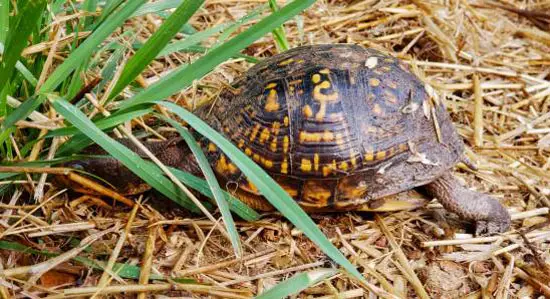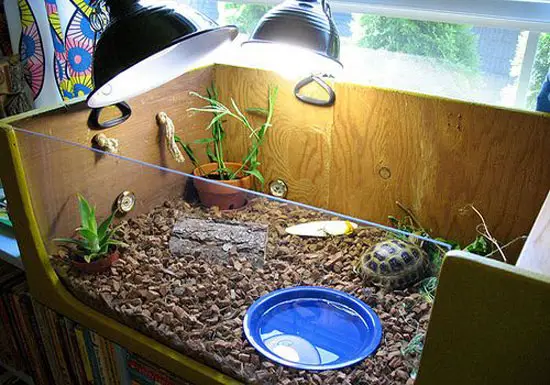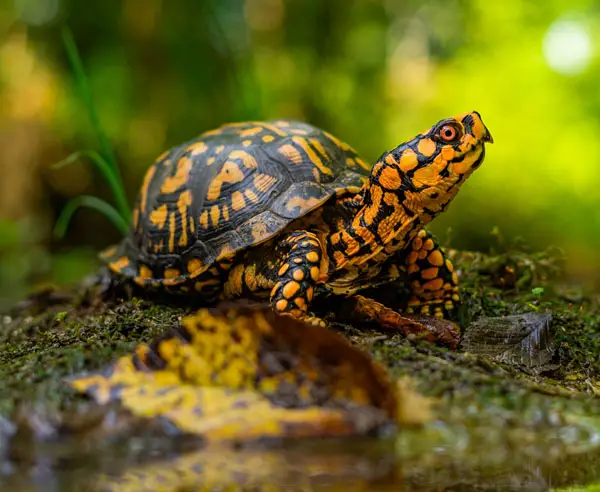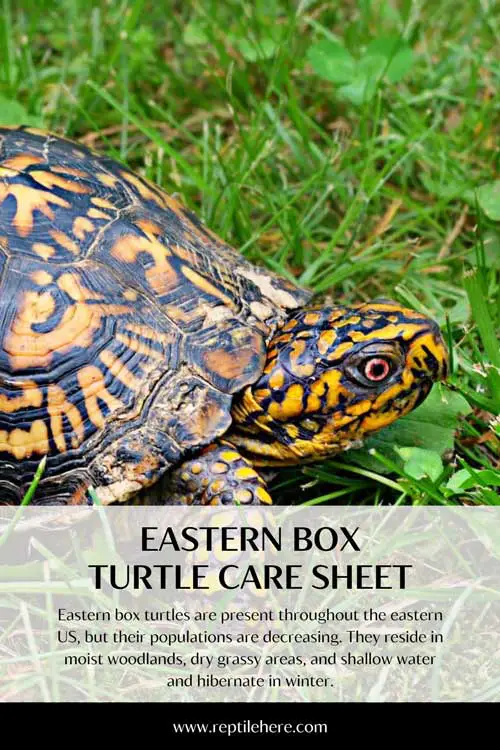Eastern Box Turtle Care Sheet: Diet, Behavior & Habitat
Eastern box turtles are present throughout the eastern US, but their populations are decreasing. They reside in moist woodlands, dry grassy areas, and shallow water and hibernate in winter.
Eastern box turtles might be perfect if you want to add a new pet to your home. These reptiles are moderately simple to care for and can be kept in any house.
In this post, we’ll outline the basics of eastern box turtle care and explain why giving these animals the best possible environment is essential. So whether you’re a first-time turtle owner or you’ve been caring for one for years, follow this eastern box turtle care sheet.
Basic Info About Eastern Box Turtle
Contents
Stern box turtles are a common turtle species found in many parts of North America. They are lowland creatures that hibernate during the winter. Box turtles are omnivorous, eating insects, worms, and other small animals.

- Scientific Name: Terrapene Carolina Carolina
- Common Name: Land Turtle, Eastern Box Turtle
- Adult Size: 5 to 7 Inches
- Max Size: 7 Inches
- Lifespan: In captivity, up to 100 years, and 40-50 years in the wild.
- Diet: They mostly swallow plant matter, including fruits, seeds, roots, fungi, and grasses. Fish, amphibians, eggs, carrion (the meat of dead animals), and more.
- Range: The eastern United States is home to box turtles.
- Behavior: If they have enough room to move around, they are pretty energetic and active.
- Clutch Size: Anywhere from two to eight eggs.
- Legal to Keep in the USA: Legal
- Extinction Status: Not Extinct
Are Eastern Box Turtles Easy to Take Care of?
While there are many different types of turtles, Eastern Box Turtles tend to be one of the easiest ones to care for.
They require a primary enclosure ( such as an aquatic turtle tank ), fresh water and hay, UVB light, access to sun exposure during the day ( during dry months), and a temperature gradient between basking/subduing temps. Besides, they will need some type of substrate or nesting area to lay their eggs.

These turtles do well in various climates and rarely require special care other than regular feedings and water changes. When it comes time to vet your turtle, you can take them to a local wildlife center or veterinarian specializing in reptiles.
How to Take Care of an Eastern Box Turtle?
Many people are very fond of eastern box turtles as pets because of their cute and slow movement. The eastern box turtles are a popular pet because they are easy to care for and make excellent watch animals.
They require minimal attention and love, which makes them perfect pets for people who have busy schedules. They do well in indirect sunlight or moderate light, but they should be kept indoors during cold weather.

Full grown eastern box turtles need water daily and food high in protein (their diet consists mainly of insects). They also enjoy leafy greens, fruit, hay, and other seeds.
Suppose their enclosure gets too dirty or moistened by rainwater runoff caused by heavy rains outside the enclosure’s door(s). In that case, box turtles will often bury themselves underground to escape wetness and odor.
Here is some organized eastern box turtles care sheet:
Provide a Warm and Humid Environment
Care of eastern box turtles includes a warm and humid environment to thrive, so ensure your home is set up correctly to accommodate eastern box turtles needs. Ensure you maintain their chamber at a comfortable temperature – between 85-88 degrees Fahrenheit is perfect.
Keep all the windows closed during winter months to maintain a consistent humidity level, and install a basking area near the heat source if necessary.
Feed Them Hay
Eastern box turtles love hay – give them plenty of it! Ensure you buy hay high in fiber content, as this will provide them with the essential nutrients they need.

Cage Them When Not Being Used
If you don’t want your eastern box turtle running around your house all day long, it’s best to keep him in his enclosure when you’re not using him. This way, he’ll stay safe and not get into trouble.
Provide Them Daily With Fresh Fruit and Vegetables
Eastern box turtles love bland food, so make sure to include lots of fresh vegetables and fruits in their diet to ensure they’re getting the nutrition they need.
If you can’t provide them with fresh vegetables and fruit, feed them ReptiBlend food instead – this low-fat diet made specifically for reptiles that include hay, fresh vegetables, fruits, insects, and water.
Provide Plenty of Clean Water Every Day
Eastern box turtle care includes providing them water daily, so keep their enclosures well-watered. You can even employ a water dish if you have one available. They need a lot of water to stay hydrated, so it’s essential to provide them with plenty of clean water daily.
You can do this by filling a water dish or putting a shallow pan of water in the turtle’s enclosure. Provide the water is constantly clean and fresh, and don’t let it get too warm or cold.
Keep Their Enclosure Completely Clean
Box turtles will defecate everywhere if their enclosure isn’t kept clean! Ensure to provide them with a wide range of water dishes, so they can access different types of water at all times.
Can You Keep Eastern Box Turtle as a Pet?
Yes, You can keep an eastern box turtle as pet. The eastern box turtles can be kept as pets, provided they are adequately housed and fed. They should not be put in homes with small children or those unfamiliar with reptiles because they may bite.

In addition to proper housing and feeding, Eastern Box Turtles require plenty of exercise; ideally, they should have access to a large outdoor area to run around and explore.
It’s essential to know as much as feasible about the needs of any potential pet, reptile or otherwise, before taking one home.
What Does an Eastern Box Turtle Need in a Tank?
Eastern box turtles can be kept in tanks ranging from 10 to 30 gallons. The most important thing for an Eastern Box Turtle tank is plenty of covers, as this turtle loves to hide.
Some types of covers that may work well for your turtle include logs, fake plants, or other tall pieces of furniture. Ensure the water flow is slow and shallow, so the turtle has plenty of room to swim and explore.
Eastern box turtles should get a balanced diet consisting mainly of hay, fresh vegetables (especially lettuce), pellets made from ground meat or fish, and occasional treats such as insects or fruit.

To maintain eastern box turtles needs and keep them comfortable and healthy, their indoor cage should look like their natural habitat. This includes plenty of places to hide, food, and water.
To provide your box turtle a good home, you’ll need at least an aquarium, terrarium, substrate, plants, enclosure, hiding spots, lighting, a water tray, dish, or area, a thermometer, a thermometer, or a hygrometer to monitor the temperature and humidity.
Precautions for Petting Eastern Box Turtles
Eastern box turtles can be amiable and beautiful creatures. However, they’re still wild animals and must be handled cautiously.

- Never Touch a Box Turtle’s Shell – This can cause the turtle pain and may even lead to death.
- Never Hold a Box Turtle by its Tail – This could cause the turtle injury or even death. Instead, hold it gently by the shell or back near the head.
- Be Careful When Moving a Box Turtle – Handling a Box Turtle awkwardly or forcefully can cause injuries. Instead, use gentle motions and move it as slowly as possible.
- Make Sure Your Hands Are Clean – If your hands are dirty, you will contaminate your turtle with bacteria that can make it sick or even kill it. Always wash your hands before handling a box turtle, and use gloves if you have to touch its shell or eyes.
Takeaways
Now that you know all about the Eastern Box Turtle, it’s time to take care of them. We have described all the aspects of caring for this turtle required to keep its health and happiness in check. Make sure you can offer a habitat with proper temperature and humidity levels to your pet box turtle. It will definitely love being out in its aquatic home!


